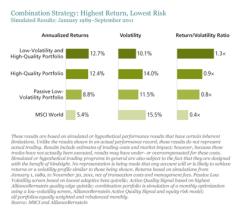The well-documented tendency of less volatile stocks to outperform the market over long periods aptly illustrates the old adage “slow and steady wins the race.” Our research shows that combining quantitative and fundamental strategies for exploiting this anomaly is likely to be more effective than using any single approach
Strategies designed to tap the low-volatility anomaly’s risk/reward potential have gained a lot of attention in recent years as investors have sought ways to minimize downside equity risks. Some strategies focus solely on reducing the symptoms of stock-price volatility or beta: among these are so-called minimum-variance strategies. Other approaches emphasize the fundamental causes of stock volatility, in many cases explicitly targeting the stocks of high-dividend payers and/or high-quality, stable-growth companies, which are inherently less volatile.
As my colleagues Kent Hargis and Chris Marx wrote in a recent white paper, The Paradox of Low-Risk Stocks: Gaining More by Losing Less, each of these strategies is effective, but each has blind spots. An exclusive focus on buying less volatile stocks tends to leave portfolios vulnerable to risks that cannot be detected through the historical lens of most quantitative risk models. It also tends to overlook potential fundamental drivers of return.
An exclusive focus on quality relies heavily on the generally strong relationship between earnings or balance-sheet stability and low volatility, but may miss near-term risks to stock-price stability that are not always apparent in a company’s fundamentals.
Kent and Chris’s research suggests that a strategy that looks for both low volatility and high fundamental quality would be more effective than one that focuses on either component alone.
Stocks that have traded less erratically in the past tend to continue doing so. As a result, it’s relatively easy to gauge a stock’s future volatility by screening its past behavior. Our research found that beta is the measure that has worked best historically, because it captures both stock-specific volatility and correlations to the market. Low-beta stocks are less correlated with each other than are high-beta stocks, so they also provide a greater diversification benefit.

We also discovered that targeting certain quality characteristics within a universe of low-volatility stocks generated even stronger returns than simply screening for low volatility, at similar levels of risk. We specifically emphasized the traits of companies with stable, highly cash-generative businesses, such as high operating cash return on assets and above-average dividend payouts and other signs of shareholder-friendly practices.
The Best of Both Worlds
But drawing on quantitative and fundamental research signals of low volatility and high quality could capture the predictive strengths of both approaches, while compensating for their innate vulnerabilities. In simulations dating back to 1989, a hypothetical portfolio that combined both characteristics maintained the higher return potential of a portfolio of stocks chosen simply for their high quality, and reduced risk more, than a portfolio of stocks chosen on the basis of a passive low-volatility screen.
The combination portfolio was also better at cushioning losses in downturns than the passive low-volatility portfolio. It fell half as much as the market during the global financial crisis, and actually rose 14% percent during the 2010–2011 European sovereign-debt crisis, when the global market slid 4 percent.
Because it works so differently from other active investing styles, the combination strategy can also be used as a source of uncorrelated equity alpha or for more efficient risk budgeting within an equity or multi-asset allocation. As such, it may be the shock-resistant strategy that many risk-weary investors are seeking today.
The views expressed herein do not constitute research, investment advice or trade recommendations and do not necessarily represent the views of all AllianceBernstein portfolio-management teams.
Joseph Gerard Paul is Chief Investment Officer - North American Value Equities at AllianceBernstein.






